If you’re like me, you won’t find your native language at the top of Steam’s most popular languages list:
| Language | Percentage | |
|---|---|---|
| 1 | English | 33.97% |
| 2 | Simplified Chinese | 29.18% |
| 3 | Russian | 9.62% |
| 4 | Spanish-Spain | 3.99% |
| 5 | Portuguese-Brazil | 3.77% |
| 6 | German | 2.88% |
| 7 | Japanese | 2.69% |
| 8 | French | 2.23% |
| 9 | Korean | 1.95% |
| 10 | Polish | 1.61% |
Source: Steam
For players like us, video game localization makes all the difference.
It helps us enjoy a video game without darting between the action and subtitles 👀. And chances are, your audience is also not very keen on developing a lazy eye. Chances are, they will enjoy your localized video game.
This guide will help you make it happen. First, I'll answer your burning questions. Then, I'll walk you through a step-by-step guide to game localization with real-life examples.
Press A to start 🎮.
What is video game localization?
Video game localization is the adaptation of a game for a new region or country. Localization involves translating dialogue, captions, and UI, adjusting visuals and audio, and adapting marketing materials to fit the target audience’s preferences and culture.
Or as Patrick Görtjes, Narrative and Audio Producer at Ubisoft’s Massive Entertainment, puts it:
💬 “The secret to great localization is to make it seem as if the game was made in the language that the player is playing.”
As great as this quote is, it’s worth noting that the player doesn’t see the game just through the lens of language. If they did, mere translation would suffice.
Game translation vs game localization
Game translation allows you to understand the dialogue and subtitles or captions. It’s the very first step in the game localization process.
Game localization goes further by making cultural adjustments that impact your game's visuals, audio, and marketing.
Or put another way, translation helps you understand the game and localization helps you love it. To bridge the gap between the two, localize the following video game elements.
Game elements requiring localization
Here’s what you need to localize in your video game:
Game content
- Subtitles and captions
- Character names
- Character design
- Sensitive content (gore, nudity, explicit language)
- Voice acting and dubbing
- Score and licensed songs
- Achievements and trophies
User interface (UI)
- UI text
- UI layout
- UI typography and fonts
Marketing and external materials
- Marketing campaigns
- Game title and slogans
- Box art
- Game store listings
- Physical extras (figurines and art books)
Monetization and legal
- Pricing
- Microtransactions
- Age ratings
- Legal disclaimers
A bit later, I’ll cover the key elements in detail. So, if you’re here for action, skip the cutscene and jump to the how-to section of this guide.
Is game localization worth the effort?
Talk to industry veterans, and you’ll learn that the video gaming industry is losing—no pun intended—steam. This is true for both giants and indies vying for the players in the crowded market.
Is there a way to boost your game’s performance?
One word: localization.
Ye olde localization was lucrative in the time of SNES when only UI text and printed tutorials were localized. And it still pays off today, in more ways than one:
- Higher global sales
- Better player experience, and as a result
- Higher review scores from international players
- Higher player retention
- Higher community engagement
- Legal compliance
- Higher marketing ROI
- No need to create poor-quality fan localizations
Video game localization process at Ubisoft
Wonder how industry titans handle game localization? Myriam Forbes, a Localization Project Manager at Ubisoft, sheds light on their localization process:
- The narrative design team writes the English script in Ubisoft’s Snowdrop engine.
- The UI design team writes UI text in Snowdrop.
- The voice design team records English lines.
- The marketing team creates marketing assets using graphic design tools.
- Textual, visual, and audio assets are stored in Ubisoft’s asset management system, Oasis.
- The localization project manager retrieves textual, visual, and audio assets from Oasis and sends them to a localization management platform.
- Ubisoft’s translators use the localization management platform to translate the assets.
- Ubisfot’s reviewers use the localization management platform to review the translated assets.
- The development team incorporates the localized assets into a build.
- The QA team tests the localized build.
To put it visually:

📝 Note: Omitted from the diagram are multiple review steps. Depending on your company structure, the localized assets might require approval from the legal team, marketing team, and brand team, among others.
With all the theoretical bases covered, you’re ready for the ‘how’ of things.
How to localize a video game
A little visualization and a little explanation go a long way. Hopefully, you now understand the localization process. Complicated? Yes. Superhuman? Absolutely not. You can do it by following these steps:
1. Perform internationalization
This is your setup step. Skip it and face repercussions down the line.
You don’t want to come up with hasty solutions when the German language starts German-languaging all over your UI. Prepare for text expansion beforehand.
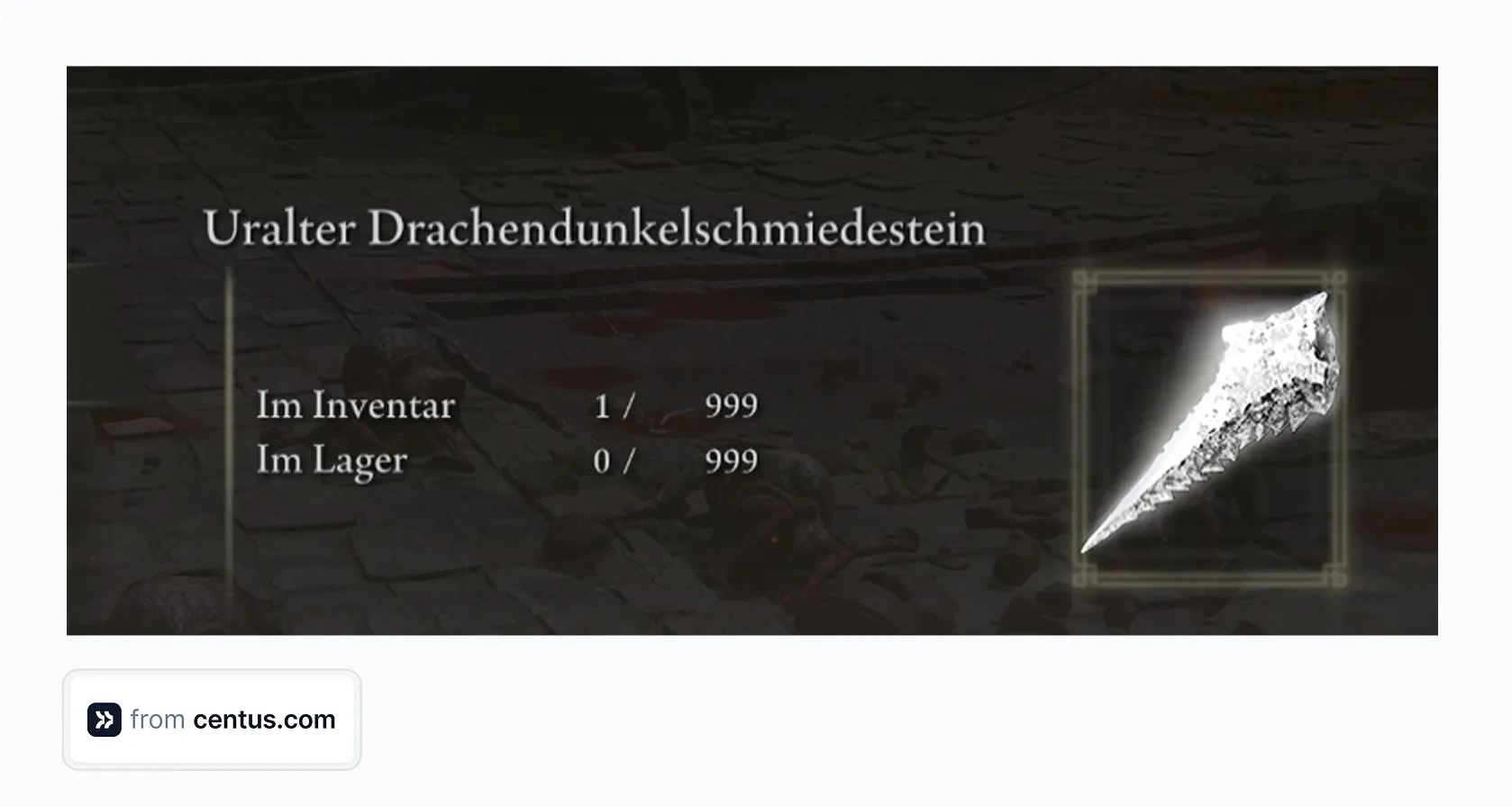
Even if creating workarounds on the fly is just another Tuesday for your team, it’s best not to deal with hardcoded strings or broken pluralization, all while coding against the clock to not delay the release.
So don’t ignore best software internationalization practices when developing your game.
2. Choose a localization release model
Decide when to start localization and, by extension, when to release localized versions.
When to start localization?
Localization starts at the tail end of production. This is a blanket statement, but it’s a helpful one.
When localizing games, inexorable forces are working against you: script changes, asset tweaks, voiceover adjustments, UI reworks, and legal adjustments. The sooner you start, the more work you’ll leave on the cutting floor, and as a result, the more money you’ll waste.
Therefore, you can’t start too early, but waiting too long could mean shipping without local versions. It’s a balancing act.
👍 Rule of thumb: Start localization once the core features are stable to avoid game release delays.
When to release localized versions of the game?
Here, you have three choices:
- Under the post-gold localization model, local versions are released after the original version. While it’s easier to localize the finished game, the drawback is revenue loss.
- Under the sim-ship localization model, local versions are released along with the original version. Although this model is more complex, it allows capitalizing on early sales.
🧐 Did you know? 37% of sales are generated in the first 3 weeks after launch.
| Game | Launch sales | Lifetime sales |
|---|---|---|
| Black Myth: Wukong | 10M copies sold in 3 days | over 10M units |
| Elden Ring | 12M copies sold in 16 days | over 25M units |
| Hogwarts Legacy | 12M copies sold in 13 days | over 25M units |
| The Legend of Zelda: Tears of the Kingdom | over 10M copies sold in 3 days | 20.8M units |
| Pokémon Scarlet / Violet (Nintendo Switch only) | 10M copies sold in 3 days | 25.29M units |
| Animal Crossing: New Horizons (Nintendo Switch only) | 11.7M copies sold in 11 days | 45.85M units |
| Cyberpunk 2077 | 13M copies sold in 10 days | over 25M units |
| Monster Hunter Rise | 4M copies sold in 3 days | 15.4M units |
| Resident Evil 4 (remake) | 3M copies sold in 2 days | 7.6M units |
| God of War: Ragnarök (PS5 only) | 5M copies sold in first week | over 15M units |
| Marvel's Spider-Man 2 (PS5 only) | 2.5M copies sold in 24 hours | over 11M units |
| Palworld (Steam) | 8M copies sold in first 6 days | over 15M units sold |
While the sim-ship localization model is ideal, it’s not always feasible. Therefore, many developers opt for the mixed localization model.
- Under the mixed localization model, some localized versions are released at launch, while others are released post-launch. This model works best under time and budget constraints. In addition to avoiding revenue loss, it provides your player community with translations so they don’t have to create fan-localized versions.
Case in point: A Japanese video game developer From Software.
At launch, the developer’s DLC to its renowned JRPG Elden Ring had only complete English localization. Other versions featured only translated dialogue and UI text, with voiceovers released in later updates.

3. Choose a localization scope
Your budget and target market size define the levels of localization for your game:
No localization
In emerging markets, games are sold without localization. The smaller the market, the lower the chance of localization. The same applies to your budget.
📝 Note: Gaming console companies often localize for small markets to boost hardware sales.
Partial localization
To keep the cost of localization down, translate only subtitles, captions, and UI, leaving the visual and audio assets unlocalized. This approach is embraced by Nintendo, which offers no or partial voice-overs in Western releases.
Complete localization
Complete localization helps your game resonate with players. It’s the best but most budget-intensive option preferred by companies with deep coffers. You know, the AAA types. Or, in the case of certain French-headquartered companies, the AAAA types 😉.
4. Choose a localization production model
This one is counterintuitive: If your budget permits, outsource localization. If not, handle it in-house.
In-house model
This model requires a localization department and a group of freelance or in-house translators. The department manages the project from start to finish, helping to sim-ship the game.
Benefits
- reduce the launch lag between the original and localized game versions
- fewer translation errors and localization bugs
- lower cost
Drawbacks
- higher involvement of the development team
- limited scaling
Outsourcing model
Here, a company or its publisher commissions a localization vendor. Usually, those are specialized games localization vendors rather than general language service providers (LSPs). The vendor manages the video game translation and quality assurance. In some cases, localization vendors are also responsible for recording localized voiceovers.
Benefits
- lower involvement of the development team
- scalable for multiple language versions
Drawbacks
- higher lag between the original and localized game versions
- less control over the localization process
- higher cost
📝 Note: Under the outsourcing model, translators often perform “blind localization,” where they don’t have access to a playable game build. To compensate for this, the vendors are provided with a game localization kit 👇.
5. Create a localization kit
The localization kit is most useful when you outsource localization. Yet, it might come in handy when your in-house team starts localizing the game early in the pipeline.
Here’s what to include in your localization kit:
- General information about the game
- Specific project requirements
- Project deadlines (deadlines for assets and deadlines for reviews)
- Localization assets (localization files, script, audio assets, visual assets)
- Reference materials (glossaries and style guides)
- Translation context (textual and visual)
💡 Pro tip: The easiest way to share translation context is through localization management platforms, where screenshots can be linked with keys and displayed alongside translated content.

6. Translate and edit textual content
Now, it’s time to render that script of yours in your players’ languages.
For video game translation, you need a team of linguists who will use machine translation (MT) to speed up the process.
I know, I know—MT is not perfect. But even if you don’t jive with it, your translators do. Especially, given that script and other textual content for your game could span thousands of pages.
🧐 Did you know? Division 2 has around 650,000 words per language.
Now is the time to lower your guard—you don’t have to release a machine-translated game. Your linguists should edit it first, following this process:
You import translatable content into a localization management platform. Preferably Centus where multiple linguists can work together to translate the script and UI into multiple languages. Simultaneously!

Once imported, the content can be automatically translated using Google Translate, Microsoft Translator, or DeepL. Then, your team can edit the generated translations ensuring accuracy and cultural relevancy.
The editing is performed in…well…the Editor, which is brimming with translator-centric CAT features. For example, glossary suggestions can help keep your item names and other terms consistent throughout the game.

In the Editor, your team can share screenshots and leave comments, which is particularly useful in the review stage of the translation process.

After editing, automatic translations will feel nothing like automatic translations. Your players won’t be any wiser, and you’ll release localized versions faster. Win-win.
Wait, there’s one more win: you’ll save the translation budget, which can be directed elsewhere. Just don’t splurge on features that make the player undetectable while swimming underwater. Or allow them to throw a knife. A single reusable knife! Like CD Project did in Cyberpunk 😉.
But even if you do decide to pursue this route—no judgment—you’ll be glad to know that by using Centus your developers can save loads of time on localization and focus on fancy features instead.
Rather than manually incorporating localization files into the build, your development team can implement a continuous localization workflow. That’s when your files are automatically pulled into the code repository:

This way your developer and translation teams always have the latest versions of files to work on. Another benefit is avoiding manual copy-pasting errors.
7. Perform cultural adaptation
Translation presupposes cultural adaptation. Proper translation, that is.
So, technically, this section shouldn’t be a standalone step. But since it really warrants your attention, I’ve decided not to lead you down the never-ending cascade of subsections and instead cover it here.
Adapt character and item names
The big mean, Mario-stomping machine Bowser isn’t the same everywhere. Well, he’s big and mean everywhere, but his localized name differs. In the original Japanese version of Mario games, he’s called Kuppa.
Examples of localized character names: Nintendo adapts character names to evoke a feeling that can be lost in transliteration or translation.
| Japanese | Romaji | English |
|---|---|---|
| クッパ | Kuppa | Bowser |
| キノピオ | Kinopio | Toad |
| ピーチ姫 | Pīchi-hime | Princess Peach |
| クリボー | Kuribō | Goomba |
| ノコノコ | Nokonoko | Koopa Troopa |
| パックンフラワー | Pakkun Furawā | Piranha Plant |
| テレサ | Teresa | Boo |
| ワンワン | Wanwan | Chain Chomp |
Examples of localized item names: The developer From Software adapts item names to better match the atmosphere of its games. Interestingly, the company works closely with the translator Ryan Morris, some of whose localized terms have even made their way back into the original game.
| Japanese | Direct translation | Localization |
|---|---|---|
| 巨大な木 | Giant Tree | Archtree |
| 大樹根 | Giant Tree Root | Archtree Root |
| 闇の仮面 | Mask of Darkness | Dark Mask |
| 反魂の玉 | Soul Resurrection Orb | Soul of Life |
| 火の戦士の手袋 | Fire Warrior's Gloves | Flame Guardian's Gloves |
Examples of localized item names: To fit the target market’s preferences, even game titles require adaptation.
| Original title | Localized title |
|---|---|
| Super Mario Brothers | Super Mario Bros. |
| The Legend of Zelda: Tingle's Balloon Fight | The Legend of Zelda: Ocarina of Time |
| Dragon Warrior | Dragon Quest |
| Mother 2 | EarthBound |
| Final Fantasy II | Final Fantasy IV |
| Resident Evil | Biohazard |
| Monhan | Monster Hunter |
| Tales of Symphonia: The Dawn of the New World | Tales of Symphonia |
| Pocket Monsters | Pokemon |
| Hoshi no Kirby | Kirby's Dream Land |
Adapt character appearance
Now, this localization change is more substantial than others and shouldn’t be taken lightly. While you don’t need to perform it for some markets, in others, your game might not speak to its target audience. Let’s see why.
Look at the two box art examples below:
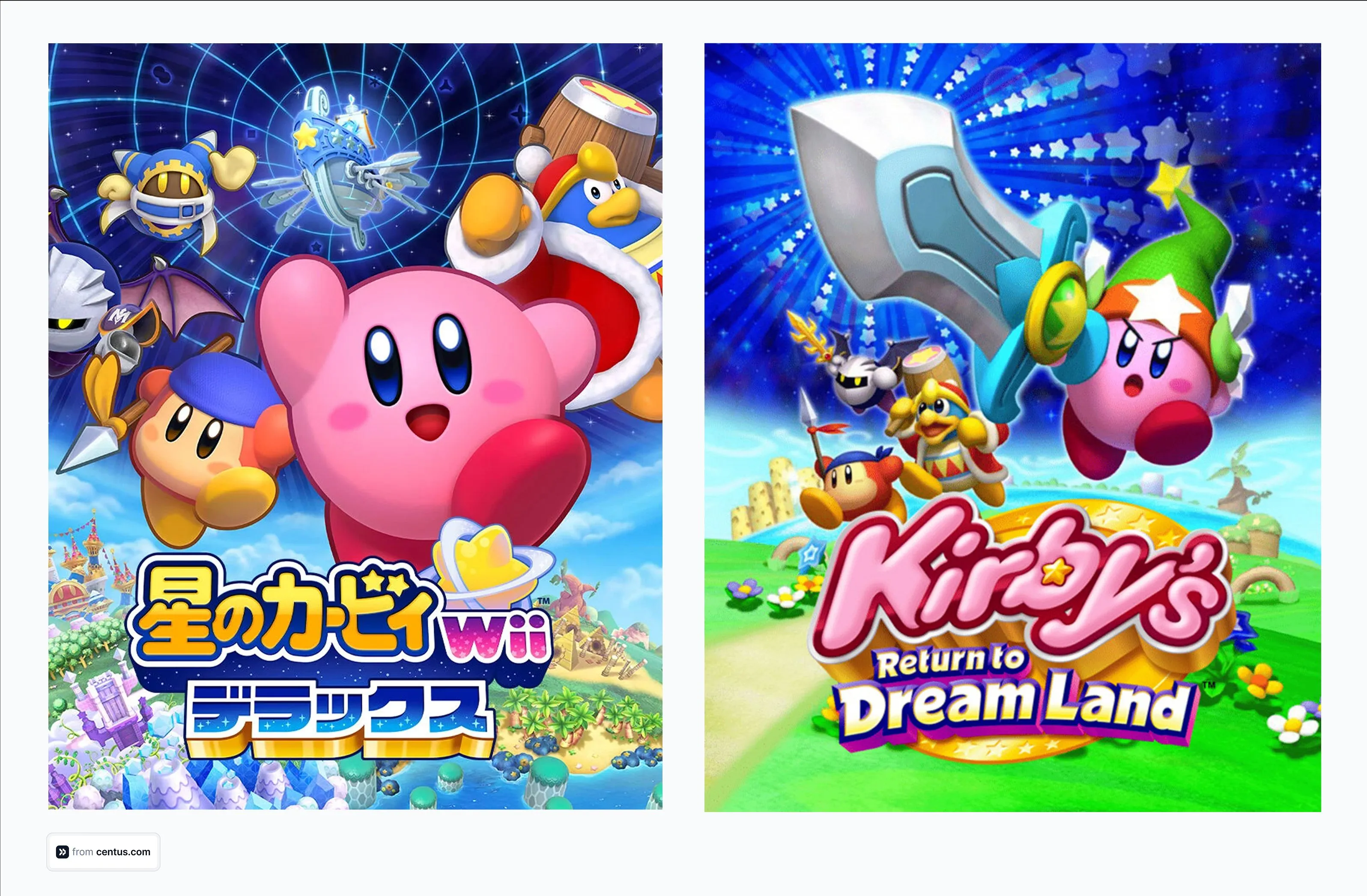 Source: Nintendo
Source: Nintendo
Notice how Japanese box art features cheerful Kirby, while its Western counterpart is out for blood?
Same here:
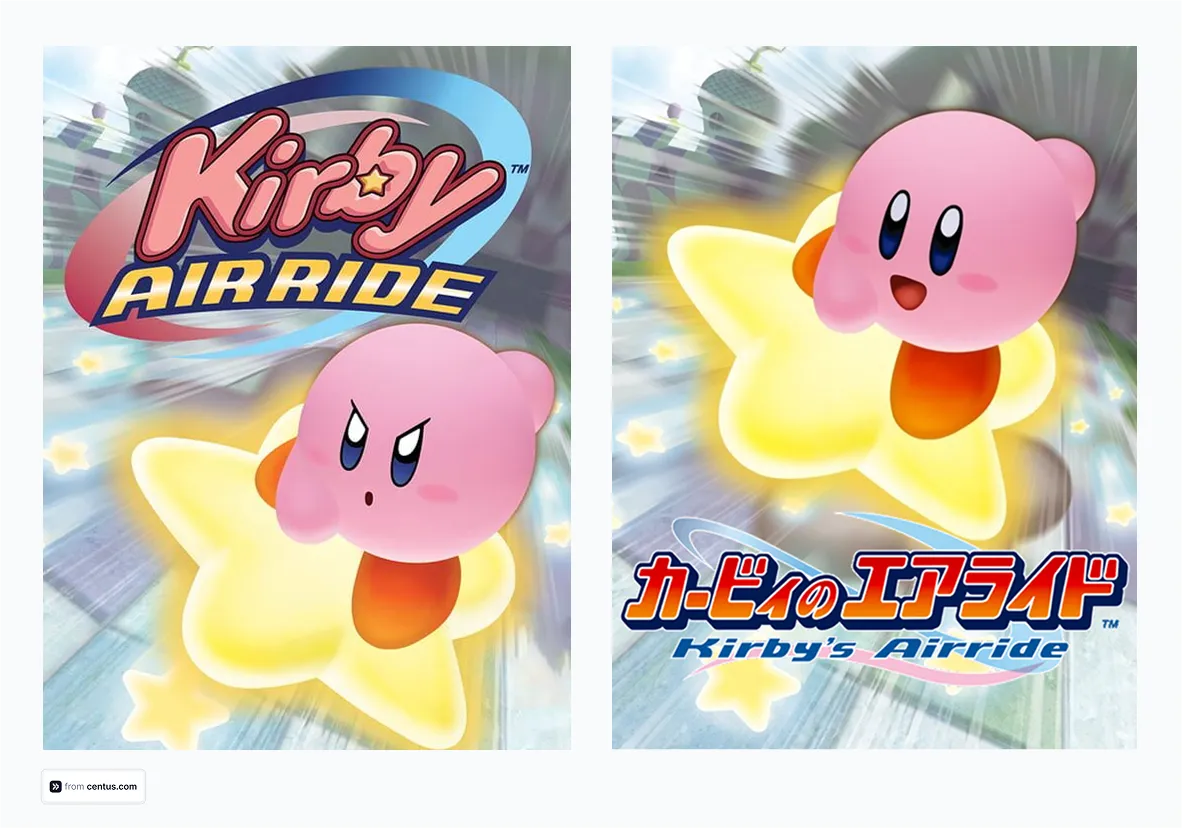 Source: Nintendo
Source: Nintendo
Nintendo’s former localization manager, Leslie Swan, comments on the change:
💬 “Cute, sweet characters are popular among people of all ages in Japan. In the U.S., though, tween and teen boys tend to be drawn to tougher characters.”
While I can’t vouch for the US audience, back in the day, pugilistic Kirby got a pass from teenage me. To get your global audience to embrace your characters in the same way, tailor them to their tastes.
8. Localize game UI
Some languages require special treatment during UI localization. You already know about the expansion of German text. You are probably also familiar with the unusual world of right-to-left (RTL) languages. If not, learn in this guide.
But did you know about UI localization of Japanese and other Asian languages?
Case in point: Japanese might require larger line spacing or smaller text sizes. For example, Fire Emblem: Three Houses has substantially smaller UI text for its English version.

Think it’s just a developer’s quirk? Localization would be easier if it were. But here’s the same thing done in Elden Ring.
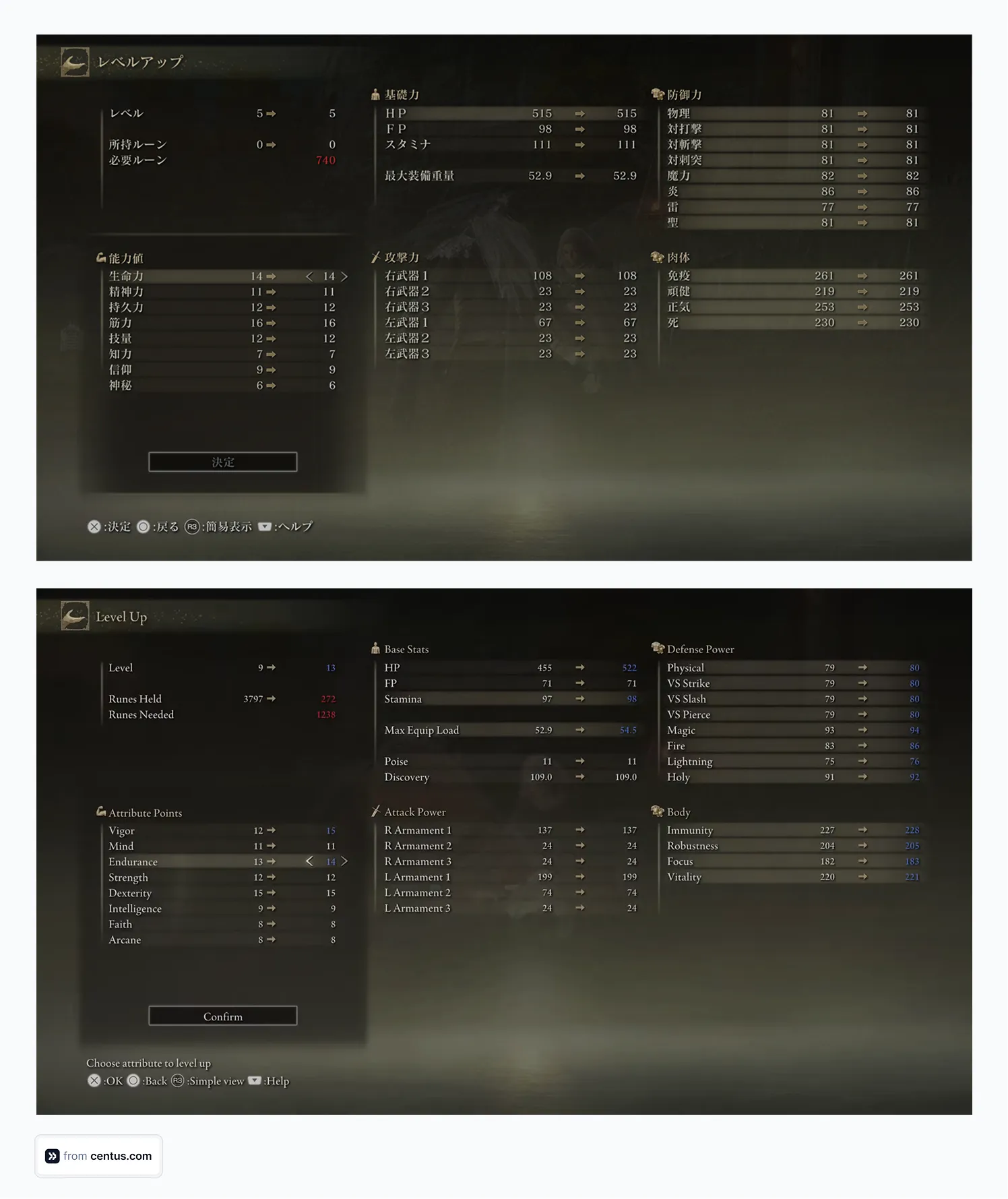
The truth is to fit some translation into UI, you need to adjust the text size and line spacing. And it’s not even the worst thing.
Some translations might not fit the UI and will need to be shortened.
This shortening can’t be done without close collaboration between translators and your design team. Organize this collaboration and UI localization will be more surgery than butchery.
💡 Pro tip: To streamline UI localization, use localization management platforms, like Centus, that integrate seamlessly with design tools. Using Centus, your design team can avoid manual copying, which is particularly prone to errors in RTL designs.
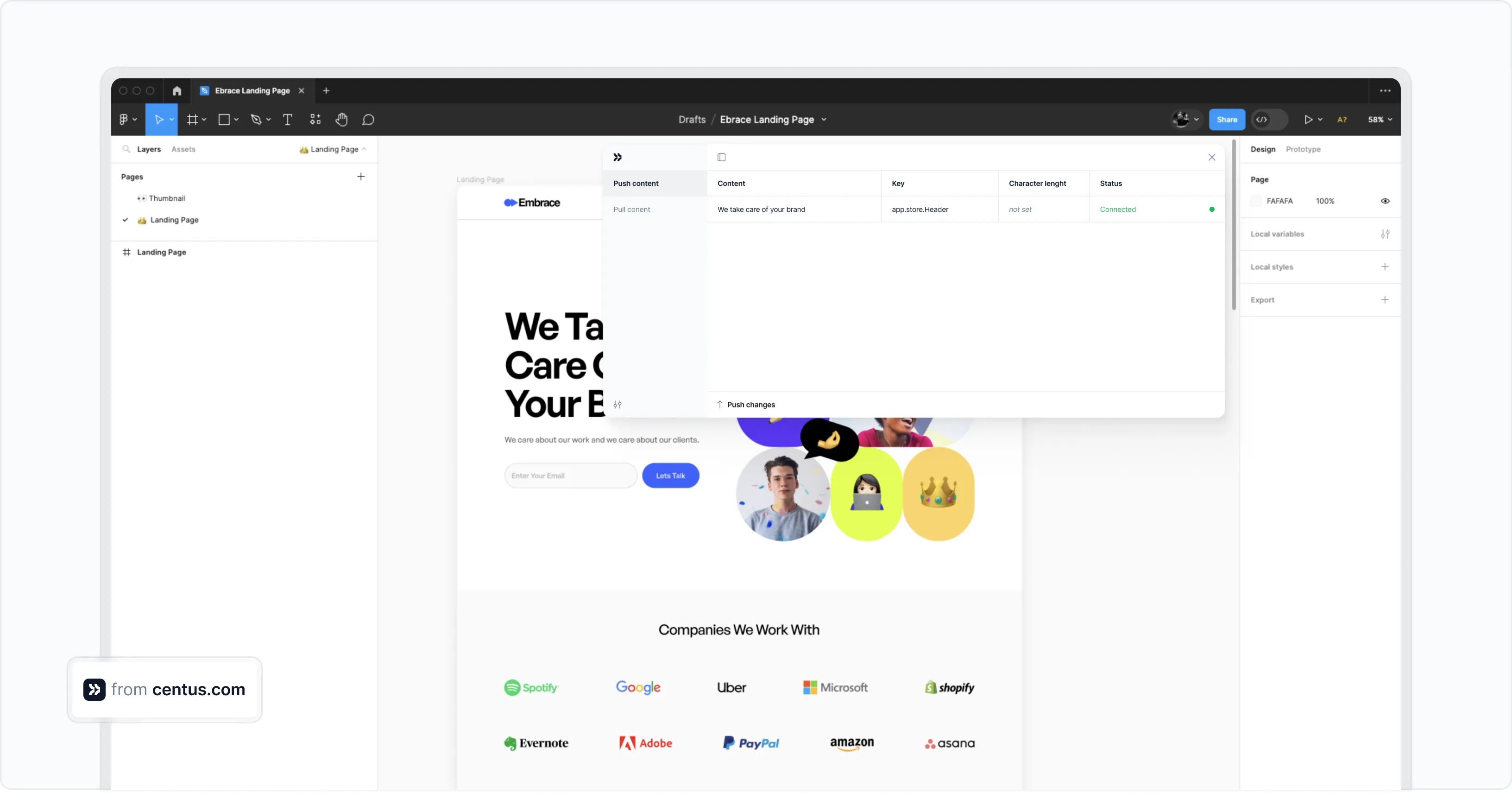
9. Perform audio localization
Time to record localized voiceovers. First step:
Localize accents
The American accent will sound off in Medieval England. Duh.
What about Medieval France? Should your characters have French-accented English in the English voiceover? While some players and developers prefer this approach, others opt for a British accent, as Ubisoft did in Assassins Creed Unity. That way, players are immersed in the time period without breaking the atmosphere.
Interestingly, Ubisoft ditched the approach in the subsequent games of the Assassin’s Creed series. Newer releases, like Assassin’s Creed Shadows, feature English tinged with regional accents.
So put accents on your localization checklist and make their selection a thoughtful, deliberate choice. While you’re at it, add dialects too.
Localize dialects
Dialects introduce further linguistic diversity into your game. Better yet, they can even enhance the game’s narrative.
Take Elden Ring with its Welsh and Cornish dialects. They both are derived from the language spoken during the Roman occupation. This creative choice better fits the game’s setting, rich with conflict and forgotten history.
👍 Rule of thumb: If your game characters are diverse, their localized accents and dialects should reflect that.
Keep in mind, this isn’t a hard-and-fast rule. There are exceptions:
Accent and dialect diversity is not always desirable.
In Swedish localization, every character sounds like they are from Stockholm. It’s because other Swedish dialects aren’t universally understood in the country.
In Spain, regional accents are also avoided in game localization as some of them could be perceived as offensive.
For some locales, standardizing accents is the way to go.
10. Perform legal adaptation
You’ve probably heard about different age rating compliance regulations across the world. So, I won’t cover those here. Instead, let’s look into lesser-known aspects of the legal localization of video games.
Example 1: Microtransactions
On March 21, 2025, the European Commission along with the Consumer Protection Cooperation Network (CPC) introduced guidelines regulating in-game virtual currencies. Among the outlined guidelines is the principle of clearly indicating prices in—Attention!—real currencies.
To decode it for humans: no more V-bucks, Robux, FIFA coins, and other forms of in-game money. Now, European players buying that Cyber Demon Genji skin should see it costs around $30 rather than its equivalent of 4,780 Overwatch coins.
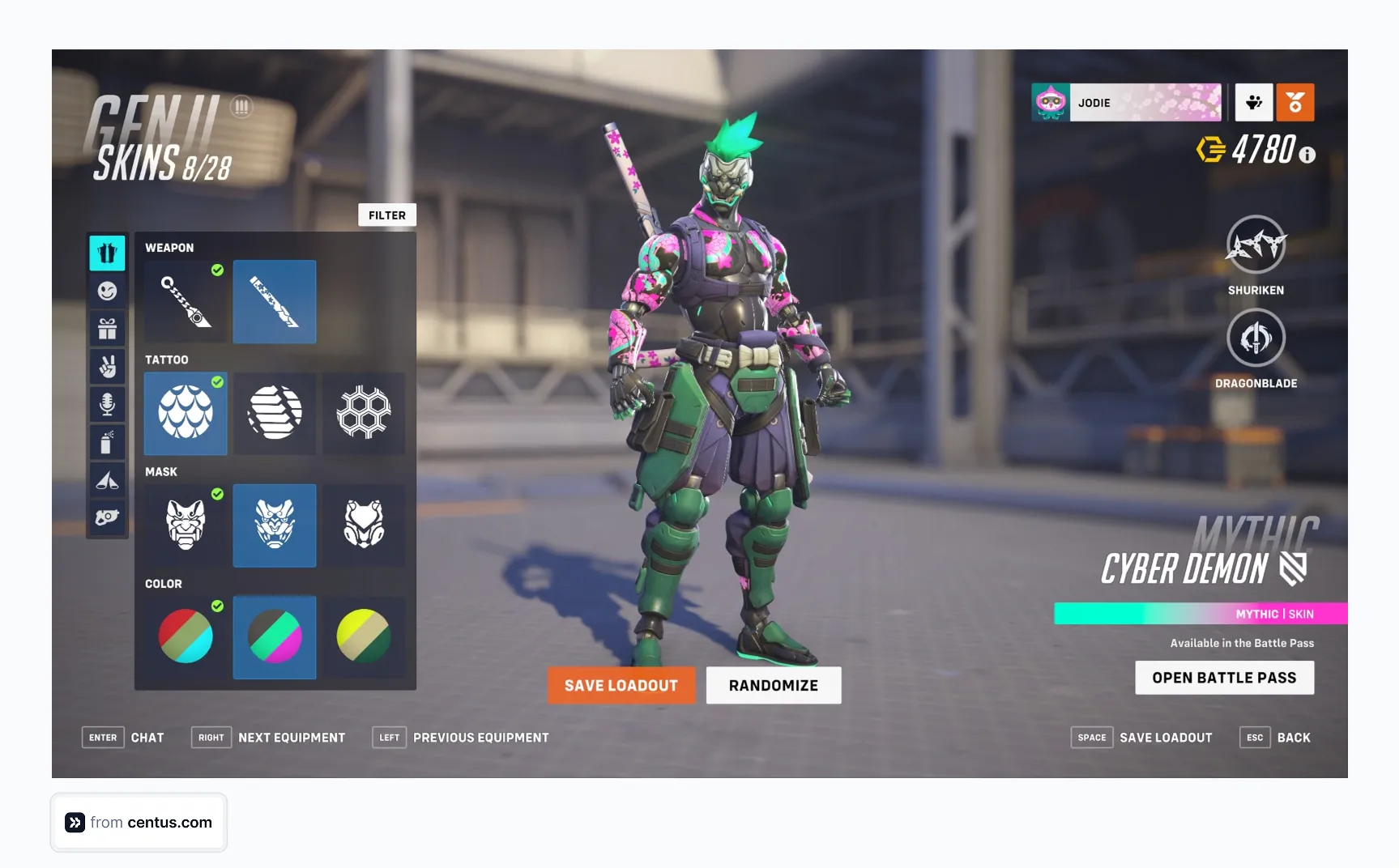
Implication for your video game?
If you’re to sell it in the European Union, make sure your use of microtransactions adheres to the guidelines. While they aren’t yet law, CPC warns the companies that it will “monitor progress and may take further actions if harmful practices continue.”
Example 2: Gore levels
Slice and dice them until the screen is dripping with giblets? You might want to adjust the level of gore for some markets to ensure legal compliance.
For example, the Brutality Switch feature that increases the level of gore in Dying Light 2 is not available in the game’s German and Japanese versions. Additionally, blood is colored gray in those locations.

Example 3: Nazi iconography
The Wolfenstein series, for example, had to be significantly altered during German localization due to the country’s strict prohibitions against Nazi iconography. Even certain mustachioed character lost his mustache.
Example 4: Copyrighted materials
Chances are, Western players will never see an official localization of Mother 3. You see, the game is chock-full of copyrighted songs, like the reprise from The Beatles' Sgt. Pepper's Lonely Hearts Club Band. And here’s the rub: The game’s publisher Nintendo has never obtained permission to use the songs in Japan, let alone other locations.
Can’t Nintendo simply swap the score for the Western release? Unfortunately not. Swapping copyrighted game assets can be excruciatingly bureaucratic and requires permission from copyright holders.
👍 Rule of thumb: Ensure you have the permissions and licenses to use copyrighted assets in each location where you want to release your game.
11. Perform debugging and quality assurance (QA)
This is localization’s final boss. An unskippable one.
Some localized versions of your game will be nigh perfect. Others will have bugs aplenty. There will be bugs in builds, bugs in the pre-master version, bugs in the release candidate (RC), and the release version itself.
Case in point: The Brazilian version of Elden Ring, where item descriptions were markedly shorter than in the Japanese and English versions. The bug was fixed in later patches.

Most players will give you a certain amount of tolerance for translation quirks. But some will hunt for the slightest signs of bugs or MT metastasis. The most glaring examples will be plastered all over Reddit.
🧐 Did you know? 57 testers worked full-time for 3 months testing the localized versions of Division 2.
If there's one takeaway from this guide, it's this: Always test and polish the localized versions of your game. And then test and polish some more.
To simplify the process, use the localization management platform Centus. It can help you identify a whole host of issues in the translated strings:
- Spelling, grammar, and punctuation errors
- Placeholder differences in the source and target text
- Leading and trailing whitespaces
- Bracket differences in the source and target text
- Number differences in the source and target text
- Email address differences in the source and target text
- URL differences in the source and target text
Wrapping up
Games sequester the player in the maze of setting, story, characters, and mechanics. To keep them roaming longer—while enjoying it—the maze should feel cozy and somewhat familiar. That’s why games are localized. And now you know how to do it.
Before you start, make sure you have a reliable localization tool by your side.
Try Centus now and see how it can help you take your game global. Game on!
Get the week's best content!
By subscribing, you are agreeing to have your personal information managed in accordance with the terms of Centus Privacy Policy ->
Keep learning
12 min. read
What Is Audiovisual Translation and How Is It Done?

5 min. read
Localization Quality Assurance: Your In-Depth Guide

11 min. read
Content Localization: What to Localize and How to Do It
10 min. read
Localization Rates and Costs for Digital Products

11 min. read
How to Perform Mobile App Localization: The Right Way
21 min. read